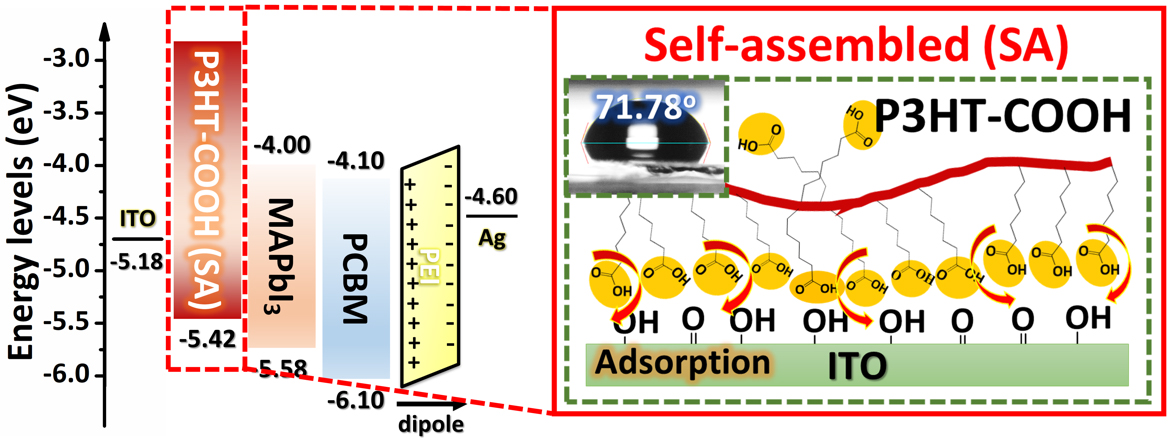-

-
Schematic diagram of the self-assembled monolayer that serves as the interface layer for the perovskite solar cell. Researchers fabricated a monolayer of polythiophene, where the modified molecules attach themselves to conducting substrates that form a perfect atomic layer and modify the surface of the conducting oxide. This interface is a successful hole collecting electrode for the solar cell on top of it. Additionally, the perovskite layer exhibits a high degree of crystallinity that greatly enhances the power conversion efficiency and device lifetime.
-
A team of Center for Integrated Nanotechnologies (MPA-CINT) researchers and their collaborators has demonstrated a new fabrication technique that shows promise in fighting moisture degradation and extending solar cell device lifetimes and efficiency, even under dim-light conditions. The work was recently published in Advanced Science.
Perovskite solar cells have rapidly increased in power conversion efficiency – the amount of solar energy converted to usable electricity – from almost 4% to more than 25% in the past 10 years, becoming the champion technology for next-generation solar cell applications. Solar cell performance, however, is typically limited by eventual corrosion of the cell’s interface layer.
To meet this challenge, the CINT team developed a self-assembled monolayer in the photovoltaic cell, allowing the electroluminescent polymer polythiophene to grow a highly hydrophobic perovskite film interface layer with full coverage on the conducting oxide surface. Solar cells fabricated using this interface layer show a high efficiency of more than 20%, a long operational lifetime of over 1,000 hours, and efficient functionality under ultra-low light conditions.
The team’s work provides new insights into photovoltaic applications, including power production and use, in indoor conditions and offers helpful understanding for other device applications such as LEDs and detectors.
The Los Alamos portion of the work, performed at the CINT, was supported by the Laboratory Directed Research and Development (LDRD) program, including Mission Foundation Research funding, and a J. Robert Oppenheimer Distinguished Postdoctoral Fellowship. The work leveraged optical spectroscopy tools available at CINT and the materials characterization capabilities provided by the Advanced Photon Source. CINT is an Office of Science User Facility jointly operated by Sandia National Laboratories and LANL.
The development of a dynamic mesoscale materials science (DMMSC) capability, which would further understanding of material performance and production at the mesoscale, could benefit this research. Specifically, DMMSC would help to probe the local material structure and lattice dynamics, which play a critical role in designing an efficient interface for opto-electronic devices.
Mission and Funding
The work supports the Laboratory’s Energy Security mission area and the Materials for the Future Science Pillar.
Reference
“Facile fabrication of self-assembly functionalized polythiophene hole transporting layer for high performance perovskite solar cells,” Advanced Science, 8, 2002718 (2021); DOI: https://doi.org/10.1002/advs.202002718. Authors: Chi-Yuan Chang, Hsin-Hsiang Huang, Shu-Ling Lin, Pang-Hsiao Liu, Yang-Fang Chen, Leeyih Wang (National Taiwan University); Wei Chen (Argonne National Laboratory and University of Chicago); Hsinhan Tsai, Wanyi Nie (MPA-CINT); Fang-Chi Hsu (National United University).
Technical contact: Wanyi Nie
| Period | Aug 1 2021 |
|---|
Media coverage
Media coverage
Title Self-assembly monolayer boosts efficiency and lifetime of perovskite solar cells Date 08/1/21 Persons Chi Yuan Chang, Hsin Hsiang Huang, Shu Ling Lin, Pang Hsiao Liu, Yang Fang Chen, Leeyih Wang, Wei Chen, Hsinhan Tsai, Wanyi Nie, Fang Chi Hsu
Media Type
- STE Highlight
Keywords
- LA-UR-21-28528
Related content
-
Publications
-
Facile Fabrication of Self-Assembly Functionalized Polythiophene Hole Transporting Layer for High Performance Perovskite Solar Cells
Research output: Contribution to journal › Article › peer-review